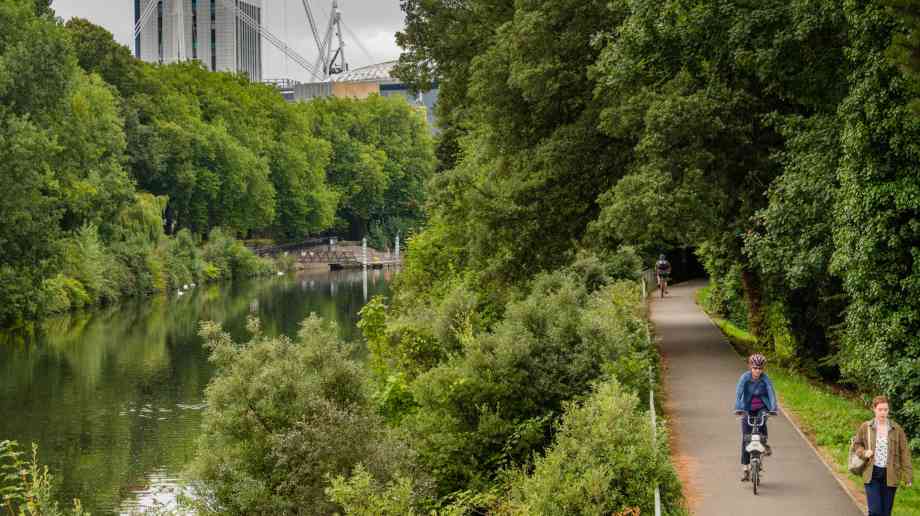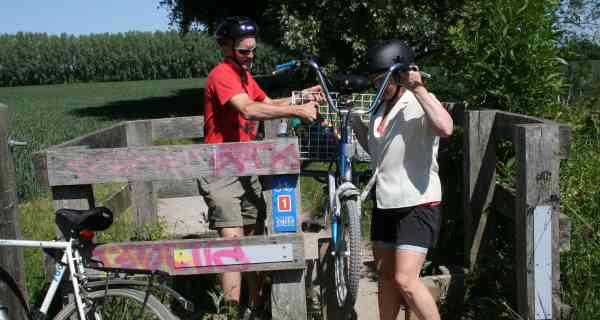Sue Robb of 4Children talks to Julie Laughton and Alison Britton from the Department for Education about the role of childminders in delivering the 30 hours free entitlement.

Walking and cycling network worth £7.6bn per annum
Rachel White, senior policy and political advisor at Sustrans, reports on the findings of the ‘Paths for Everyone’ report, highlighting how the Network is a huge opportunity for central and local governments to transform the way people travel
The National Cycle Network is a local asset with national reach. Its walking and cycling paths stretch 16,575 miles across the UK and pass within a mile of 57 per cent of the population’s homes. It already generates £3.8 billion per year to the economy from its contribution to local businesses and in health benefits from increased physical activity, reduced congestion and improved air quality. But, as the first ever review of the Netlwork unveils, its full potential is yet to be reached.
Despite its name, the National Cycle Network is used by a multitude of people of all ages and abilities, and for a variety of reasons, including leisure, commuting to work or getting to a local park. In 2017, 4.4 million people made 786 million journeys on the Network, and over three times as many journeys were made on foot than by bike per mile.
The Network has grown over 23 years and not only joins up cities, towns and villages across the UK but provides access to some of the UK’s most important natural assets, including all 15 National Parks and 18 out of 25 of our UK World Heritage Sights.
Each year journeys made on the Network contribute £88 million through reduced road congestion only and an additional £2.5 billion from the leisure and tourism it generates to local economies. The health benefits from increased physical activity also contribute to the economy and prevent 630 early deaths a year.
However, a significant proportion of the routes are not at the quality for everyone to use – a standard in which a 12-year-old could use unaccompanied or one in which the routes are accessible to all users regardless of disability, or whether they have a pram or adapted bike.
Sustrans would like to see the Network truly become a path for everyone. Our report, Paths for Everyone, unveils the results of the first ever review of all the paths on the Network, a vision of where we see the Network in the future; and actions to undertake to reach that vision.
The Network at present
Creating paths for everyone comes with a significant number of challenges but the benefits to local people and economies will be huge. Currently 32 per cent of the Network is on traffic-free paths – such as the Bristol Bath Railway Path – but 68 per cent is on roads and it’s largely these sections that prevent it from being accessible to everyone due to the speed and volume of traffic. This can put off many people from using the routes, especially those who are less confident to ride a bike and families. This is why we found that only four per cent of users in 2017 were new or returning cyclists – as only more confident cyclists were happy using on road routes.
Furthermore, barriers and pinch points – especially on the traffic-free paths, prevent access to many users, particularly those with adapted bikes and prams. Over 16,000 barriers need to be removed or adapted to make these paths truly accessible to all. These issues, combined with poor surfaces and signage means that currently 46 per cent of the network is in a poor or very poor condition.

Unlocking the Network’s potential
There are a number of actions Sustrans would like undertake, working with local authorities, to improve the Network.
For the Network to reach its full potential and attract more people by 2040 a number of things need to occur, including: doubling the amount of routes and paths that are traffic-free over the next 22 years. This will involve finding alternatives to some current on road routes or building pathways along roads; removing or redesigning the 16,000 barriers that currently permeate the traffic-free sections of the network – equivalent to three per mile on these stretches, to ensure everyone, whether they are getting about by foot or by bike has access; redesigning junctions where traffic-free routes intersect with roads to ensure they are safe; and reducing speeds to create quiet-way roads where the Network remains on road. To do this, speeds should be limited to 20mph in built up areas with high numbers of traffic flows and 40 mph or less on quiet rural roads with low traffic flows. There also needs to be good signage to warn people driving to expect people on bike and on foot.
Working with local authorities, Sustrans aims to deliver 55 projects across the UK, ranging from improving signage to redesigning junctions and creating traffic-free paths. These are to be finalised by 2023.
By 2040, we would like to see a network completely made up of traffic-free and quiet-way routes, where the whole all the paths are of a good or very good quality with low speeds, good signage, great surfaces and no barriers.
Next steps
All of this takes time and money of which local authorities have little. Funding will need to come from a vast variety of sources but the benefits will be huge. Sustrans has estimated that over the next 22 years a £2.8 billion investment into the Network across the UK will be needed to achieve the recommendations. This will result in benefits to the economy of £7.6 billion a year by 2040 – up from £3.8 billion per year in 2017, as a result of increased trips and journeys on a Network that is accessible to all.
At a time when we have record levels of obesity, congestion and air pollution, which costs the economy billions each year, it makes sense to invest in something which is proven to tackle all three areas and provide real economic benefits. These are in addition to all the less measurable social and societal benefits that the Network can bring – the links it makes between communities.
In pure transport terms, the National Cycle Network presents a huge opportunity for governments at all levels to transform the way people travel. But the benefits of investing in the Network will be seen right across government, like relieving pressure on the NHS budget.
National governments are beginning to invest in the Network and all four backed the review with the Scottish Government investing £7 million this year in the network in Scotland and the Department for Transport investing one million with ongoing conversations around future funding. However, more needs to be done to ensure this unique asset is utilised; meets its financial potential locally; and is a path that is open and enjoyable to all.
Company Focus
Just Lanyards is a subsidiary name of Gifts 2 Impress Limited, who have been trading for over 25 years, we therefore pride ourselves in having endless experience covering all aspects of the promotional merchandise industry.
Event Diary
UKREiiF has quickly become a must-attend in the industry calendar for Government departments and local authorities.
The multi-award-winning UK Construction Week (UKCW), is the UK’s biggest trade event for the built environment that connects the whole supply chain to be the catalyst for growth and positive change in the industry.
Supplier Profiles
Geo Energy
At GeoEnergy Design, we're on a mission to disrupt the traditional way heating and cooling ha
Latest Features
Professor Harith Alani, director of the Knowledge Management Institute at the Open University explains how AI can be used for good and bad.
Alex Lawrence, head of health & social care, techUK sets out techUK’s Five Point Plan for CareTech.












